How to setup optional extras that sell with a base product e.g. gift wrapping, personalisation etc
For a shopping experience as unique as your customers
From adding a personal engraving to upgrading to premium fabric, customizing products can keep your customers coming back. With Product Add-Ons, you can offer special options to your customers in a snap.
Product Add-Ons allow your customers to personalize products while they’re shopping on your online store. No more follow-up email requests—customers get what they want, before they’re done checking out.

Add options via text boxes, dropdowns, text areas, checkboxes, custom price inputs, even sample images. Add-ons can be added globally or per-product from the edit product page.
Give your customers the options they want
Product Add-Ons is one of the most popular extensions available for WooCommerce. It gives you and your customers even more options, including (but definitely not limited to):
Image-based selections

A picture’s worth a thousand words, so why describe a customer’s personalization options when you can show them? With image-based selections, customers can see what they’re getting before they buy.
Flat fees

Charge customers a flat fee regardless of how many products they ordered. Perfect for a one-time set-up charge or a rush fee.
Percentage fees
Charge a fee for the add-on based on a percent of the total price—this is especially useful for service-based add-ons that can be tougher to boil down to a flat fee.
Text input
Let your customers enter custom text to create a custom t-shirt, add a monogram or personalize a card.
Dropdown
Customer can chose between a few pre-defined options with a drop-down field for your add-on.
Checkboxes

Make customization as easy and satisfying as checking a checkbox. Great for add-on services, like gift wrapping or express shipping.
Custom price
Let your customers name their price, perfect for tips, donations and gratuity!
Add-ons can be named, described, reordered and (optionally) given prices.
The extension also works with:
- WooCommerce Subscriptions – add additional options to subscription products.
- WooCommerce Bookings – offer upgrades like an oil treatment for a massage, priority seats for their tour or a rush fee for their rental.
Once set up, add-ons appear on product pages just above the add to cart button.
Product Add-Ons
Product Add-Ons allows you to add paid or free options to your products using several field types including radio buttons, checkboxes, drop-down fields, custom text inputs and more.
This extension also works with WooCommerce Subscriptions (separate purchase) to add additional pricing to the recurring subscription.
Installation
- Go to Plugins > Search for product add-ons>
- Click Activate.
Setup and Configuration
To create add-ons, use the Create Add-Ons button shown at the top of the screen upon installation.

Or go to Products > Add-Ons and then select Create New. You can add product-level add-ons by editing a product.
Settings

Add-on settings allow you to configure add-ons that apply to all products, or products in selected categories. This includes:
- Name: Used to differentiate add-ons from one another, this is not displayed on the website. By default, this is filled in for you.
- Priority: Specify the order in which to display, if there is more than one add-on activated. An add-on with priority 1 would be above an add-on with priority 10.
- Product Categories: Set to All products, or choose categories to apply the add-on. Removing the All products tag will deactivate the add-on, which can be handy for seasonal add-ons or time-specific add-ons.
Save when you are done. Next, we’ll cover adding the actual add-ons.
Field types
Add-on fields are added the same way for both per-product and global add-ons. This panel is found on a new or existing product. To add your first add-on, click the “Add field” button. This will insert a blank add-on:
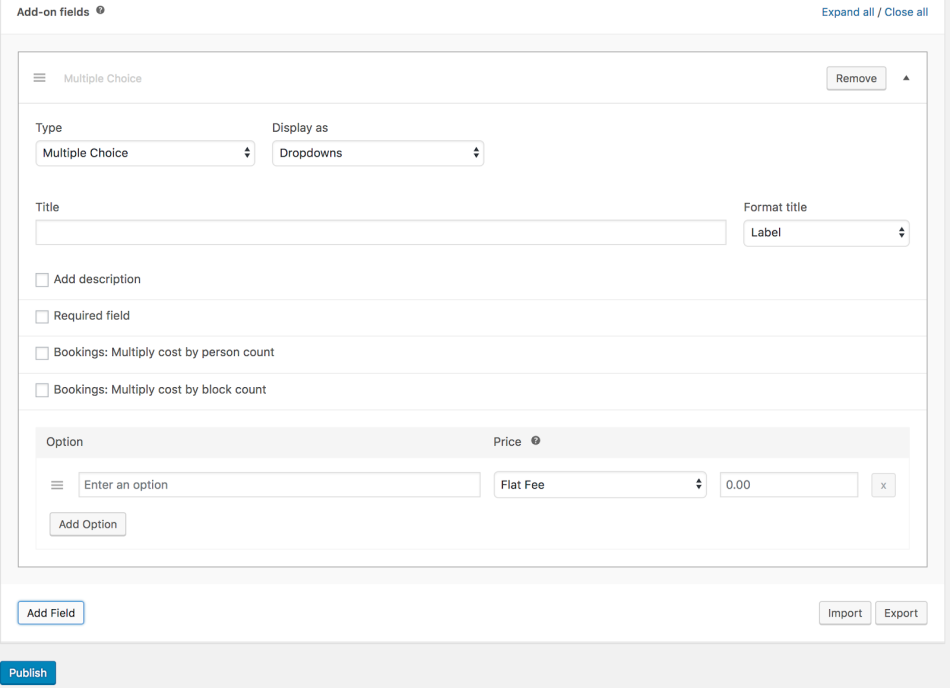
Select a field type from the top-most select box. As of writing, these options are available:
- Multiple choice – This shows a list of options the user can choose from. Display as dropdowns, images, or radio buttons.
- Customer-defined price – This shows a field where users can enter a numerical value that is added to the product price.
- Quantity – This shows a spinner where users can input a number.
- Checkboxes – Shows a checkbox or checkboxes that can be ticked/unticked by a customer.
- Short text – There are five in-built types. This shows a text field where users can enter either any text; just letters; just numbers; both; or an email address only.
- Long text – This shows a text field where users can write multiple lines of text (character limit possible).
- File upload – Allows users to upload a file.
- Heading – Add a heading between add-ons to group them into sections.
Multiple choice
Customers choose only one option from a set of predefined options. Examples: Color or size.

- Title: Format the title as a Label or Heading, or hide it.
- Display as: Choose how to present options to customers. Display as Dropdowns, Images, or Radio Buttons (see below).
- Add a description: Displays more information about the add-on underneath the heading.
- Required field Prevents product from being added to cart if an option is not selected.
- Options: Add a label for each option as well as a price if needed. Calculate the price as a flat fee regardless of quantity, per quantity ordered, or, charge a percentage of the total. To remove an option row, click the ‘X’.
If the display option is set to images, an image upload icon will show up next to each option.
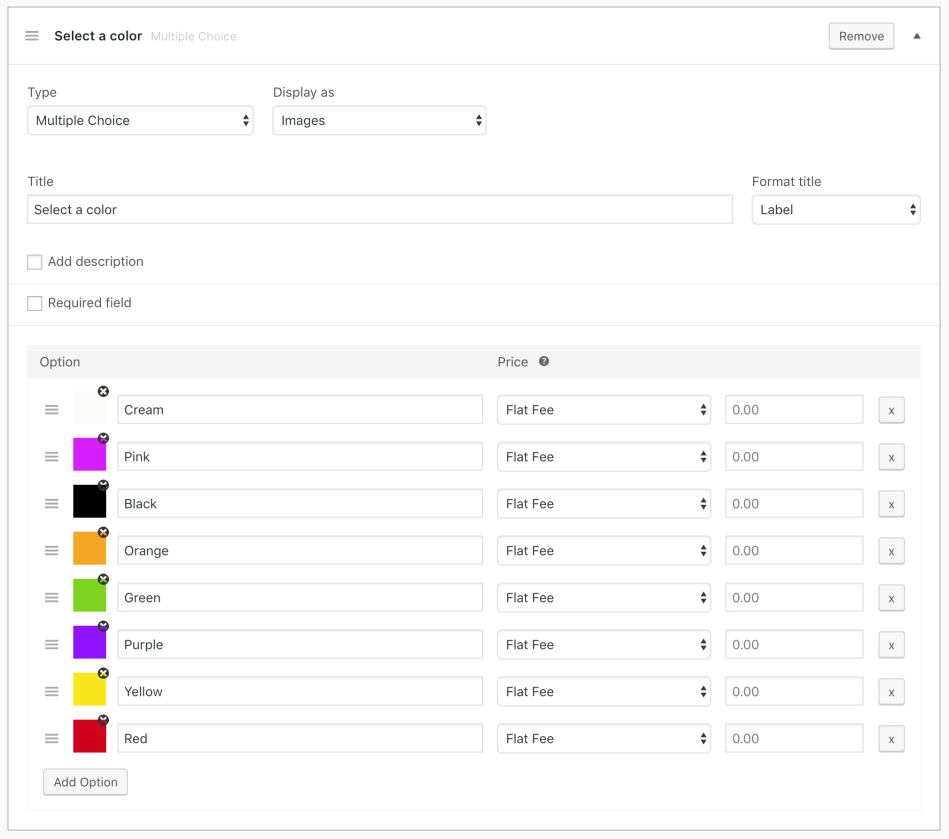
Website display
Radio buttons:

Dropdown

Checkboxes
Customers choose one or multiple options. Examples: Gift wrapping, card, or upgrades. 
- Title: Format the title as a Label or Heading, or hide it.
- Add description: Displays more information about the add-on underneath the heading.
- Required field: Prevents product from being added to the cart if an option is not selected.
- Options: Add a label for each option as well as a price if needed. Calculate the price as a flat fee regardless of quantity, per quantity ordered, or, charge a percentage of the total.
Website display

Short text
Customers can enter a single line of text. Examples: Email address, names, and engraving text.
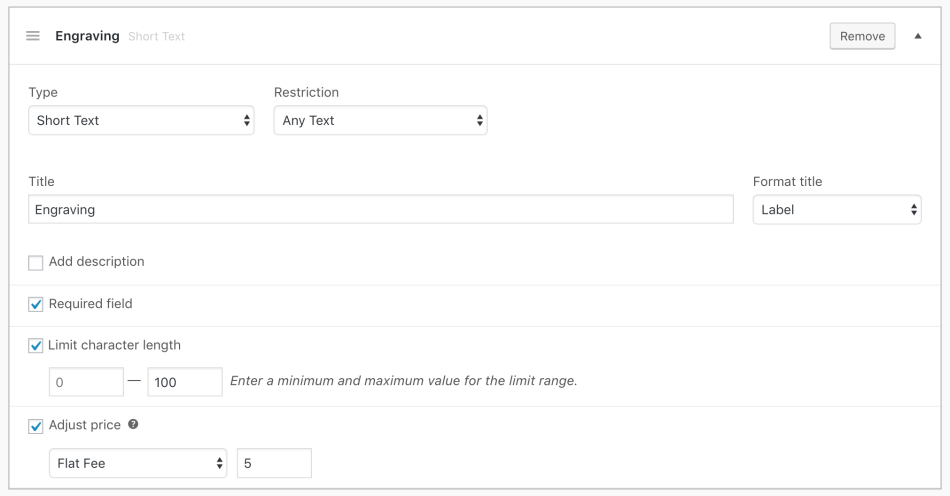
- Title: Format the title as a Label or Heading, or hide it.
- Restriction: Limit the type of characters customers can enter from Any Text, Only Letters, Only Numbers, Only Letters and numbers, only Email Address.

- Add description: Displays more information about the add-on underneath the heading.
- Required field: Prevents product from being added to the cart if the field is empty.
- Limit character length: Specify the minimum/maximum number of characters.
- Adjust price: Add an additional cost to the add-on. Calculate the price as a flat fee regardless of quantity, per quantity ordered, or, charge a percentage of the total.
Website display

Long text
Customers can enter multiple lines of text. Examples: A gift note, an address, or special instructions.

- Title: Format the title as a Label or Heading, or hide it.
- Add description: Displays more information about the add-on underneath the heading.
- Required field: Prevents product from being added to the cart if the field is empty.
- Limit character length: Specify the minimum/maximum number of characters.
- Adjust price: Add an additional cost to the add-on. Calculate the price as a flat fee regardless of quantity, per quantity ordered, or, charge a percentage of the total.
Website display

File upload
A customer can upload their own file. Example: To create custom designs on t-shirts, mugs, or business cards.
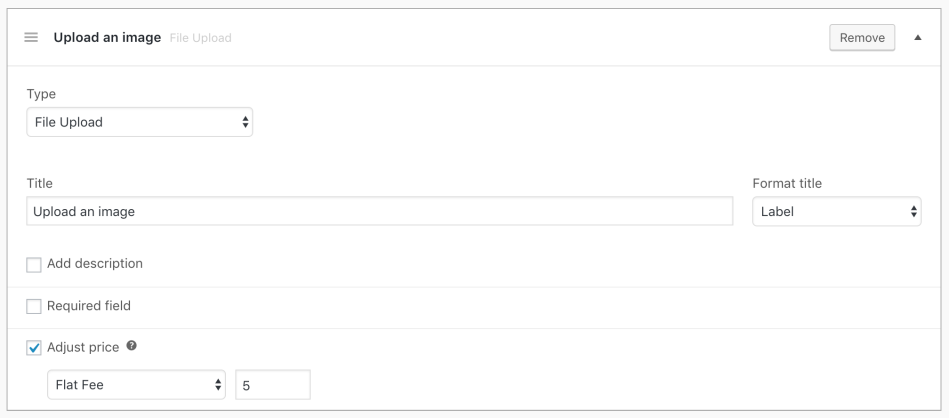
- Title: The title is displayed above the multiple choice options. You can format the title as a Label, Heading, or hide it.
- Add description: Displays more information about the add-on underneath the heading.
- Required field: Prevents product from being added to the cart if the field is empty.
- Adjust price: Add an additional cost to the add-on. Calculate the price as a flat fee regardless of quantity, per quantity ordered, or, charge a percentage of the total.
Website display

Customer-defined price
A customer can set their own price, which is added to the total. Example: Donations, tip. This amount will be multiplied by the quantity ordered.
- Title: Format the title as a Label or Heading, or hide it.
- Add description: Displays more information about the add-on underneath the heading.
- Required field: Prevents product from being added to the cart if the field is empty.
- Limit price range: Specify the minimum/maximum price.
Website display
Quantity
Customers can select a quantity. Example: Used for ordering additional items that go with the main product.

- Title: Format the title as a Label or Heading, or hide it.
- Add description: Displays more information about the add-on underneath the heading.
- Required field: Prevents product from being added to the cart if the field is empty.
- Limit quantity range: Specify the minimum/maximum quantity.
- Adjust price: Add an additional cost to the add-on. Calculate the price as a flat fee regardless of quantity, per quantity ordered, or, charge a percentage of the total.
Website display

Heading
Use headings to separate your add-ons into sections.

Website display
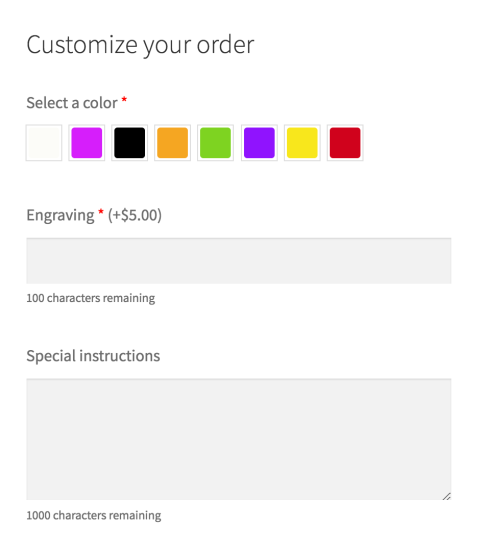
Pricing

Prices can increase or decrease the total cost of the product. Three price options are available:
- Flat fee: Price applied only once, regardless of the quantity ordered.
- Quantity based: Price is multiplied by the product quantity.
- Percentage based: Calculates a percentage of the total.
Re-order add-ons
You can change the order of add-ons displayed within groups by dragging and dropping.
Importing / Exporting add-ons
Add-ons can be exported and imported using the buttons when editing a per-product or global add-on. Click ‘export’ to export the existing fields as serialized data. Then click import to paste the serialized data and append them to your existing add-ons.

Import and Export are also available for Global Product Add-Ons.

Per-Product Add-Ons
Per-product add-ons only display for the product they are added to. Edit one of your products to add product-level add-ons. They appear in the Product Data panel under the subsection “Add-ons.”
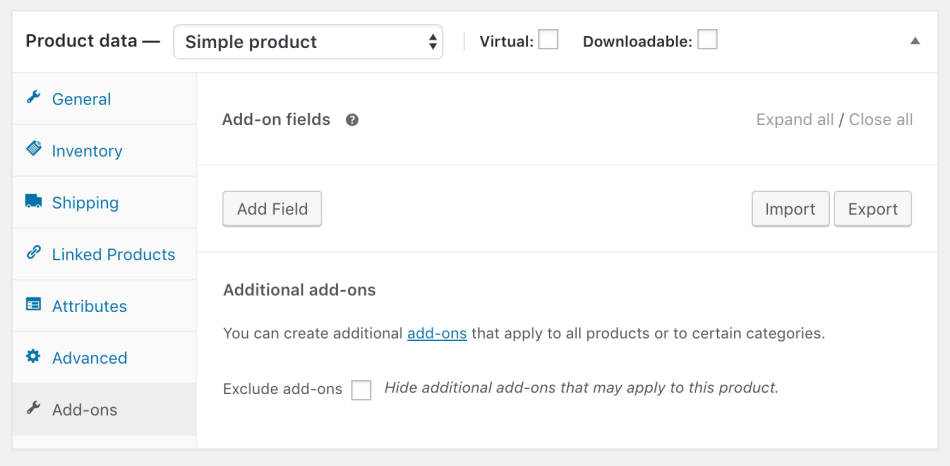
Important Note
Add-ons can be applied to variable products, but can only be defined at the product level. Example: You cannot have an add-on for a specific variation of a variable product — for a blue shirt only.
Exclusions
When creating add-ons on a per-product basis, you can choose to exclude all other add-ons that were previously applied to the product.

Frontend display and viewing order add-ons
On the frontend, add-ons are shown on the single product page above the cart button. To see how your add-ons look, select “Preview Changes”:
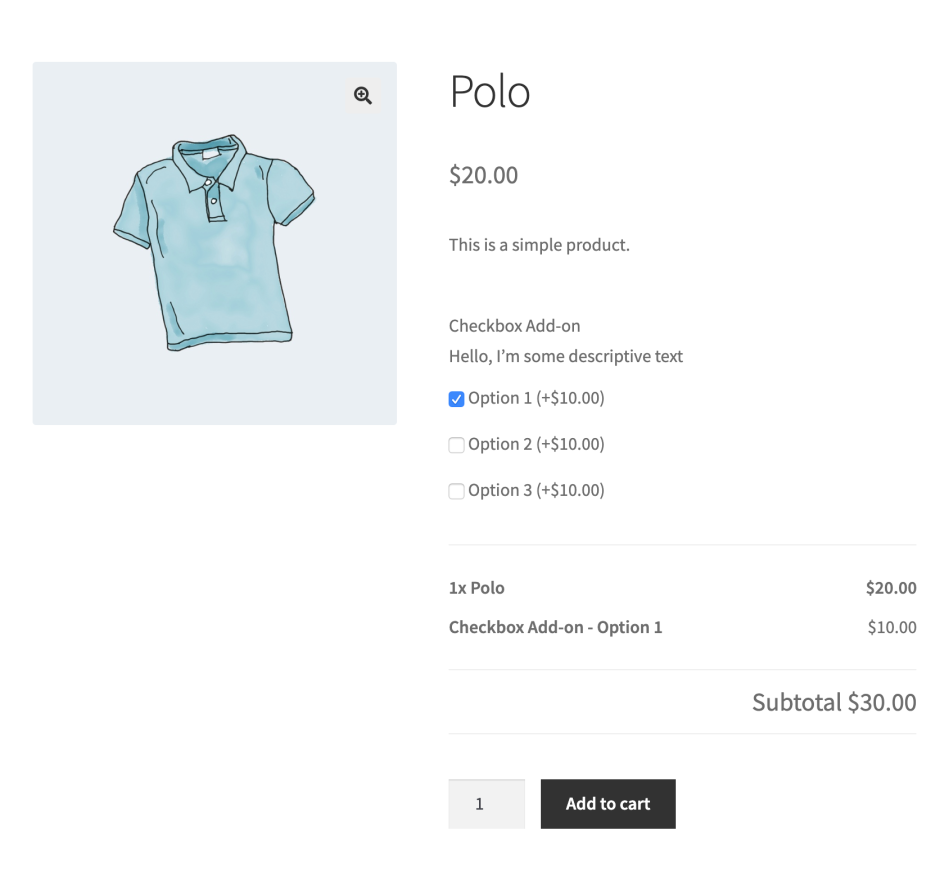
This is how it will be displayed in the cart page:
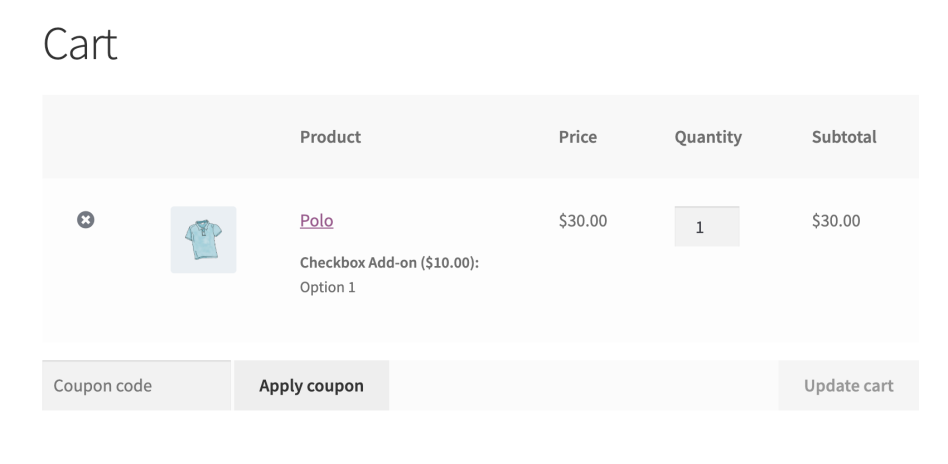
Once a customer adds this item to their cart, data will be shown as meta:

Add-on data is stored to the order line items as meta. There is no separate line-item for the add-on itself. View your order to see the chosen values.
Keeping uploads secure
Uploads are stored in randomized folders under wp-content/uploads/ to make them hard to find. However, some hosts enable directory listing, which allows people to browse your file/folder structure. To disable this ‘feature’, add the following to your main .htaccess file:
Options -Indexes
Troubleshooting
The upload field type doesn’t work
This can be due to the length of the field name. Try to reduce the field name length or contact your hosting company to increase the value of post.max_name_length.
Frequently Asked Questions
Can Product Add-Ons be imported via the Product CSV Import Suite?
No, Product Add-Ons are made up of complex serialized meta data that would be difficult to do in a product CSV row as plain text. CSV Import can only import meta that is unserialized unless otherwise stated. However Product Add-Ons itself allows you to import and export settings.
Can an add-on have a separate SKU for sales/tracking purposes?
No. An add-on is treated as an option, not a separate product. Products and their variables have SKUs.
Can I add a datepicker?
WooCommerce Product Add-Ons does not have a datepicker. However, we are looking into adding this possibility in a future version of the extension. Add your votes to this idea on the Ideas Board to help prioritize the feature.
How to customize “Grand total” and “Options total”?
Both “Grand total” and “Options total” can be targeted via CSS, granted it is a bit tricky. Here is how using the nth-child selector:
| /*Options Total*/ | |
| .product-addon-totals dt:nth-child(1) { color:red;} | |
| /*Options Total Sum*/ | |
| .product-addon-totals dd:nth-child(2) { color:red;} | |
| /*Grand Total*/ | |
| .product-addon-totals dt:nth-child(3) { color:blue;} | |
| /*Grand Total Sum*/ | |
| .product-addon-totals dd:nth-child(4) { color:blue;} |
How can I set default input values?
You can use a custom script to set default values, by inserting this code into a JavaScript file. Alternatively, you can use the free Custom CSS JS to add the code snippet.
Note that this code example only sets the value for the Custom price input field to 0 , so make sure to personalize it to your needs.
| // Set default value to 0 for Custom price input | |
| jQuery(document).ready(function(){ | |
| jQuery('.wc-pao-addon-custom-price').val("0"); | |
| }); |
Can I add custom fields to variable products?
Yes! Here is a sample:

Can I have Product Add-Ons applied once to the product, no matter the quantity ordered?
Yes. Product Add-Ons version 3.0x introduced a flat fee feature.
Why are my add-ons blank?
It might be due to not clicking Save, after adding/deleting/editing any fields.
Where do I place my language files?
.mo and .po language files for Product Add-Ons must be placed in the following path: /wp-content/languages/plugins/. Learn more on translating extensions here.
How can I change the position of the add-ons on my product page?
If you are using our Storefront theme, the add-ons will appear neatly between the short description and the Add to Cart button.
However, on many other themes, the Add Ons are displayed beneath the Add to Cart button, which can be confusing for the customer.
To change the position, you can overwrite the template structure via a theme. Note that in the case of Product Add-Ons you need to place those template override files into a folder named addons within woocommerce-product-addons in your WordPress theme (instead of placing them directly into the WooCommerce folder in that theme). That would be: Theme-Folder/woocommerce-product-addons/addons/template-file.php
Can Product Add-Ons be used to apply a discount
Yes! Product Add-Ons can be configured to reduce the price of a product – just add a negative value to the Pricefield:

Is this compatible with Smart Coupons (separate purchase)?
Yes, as of version 2.9.0, Product Add-Ons works with Smart Coupons, including the gift card feature.
Is this compatible with WooCommerce Bookings (separate purchase)?
Yes!
Is this compatible with WooCommerce Blocks?
Yes, since version 3.4.0.
Does Product Add-Ons allow me to use conditional logic?
Product Add-Ons does not have support for conditional logic. If you want to show customers different fields based on information they fill out, we recommend that you use Gravity Forms along with the Gravity Forms Product Add-Ons extension.
Can I add orders via the admin backend with Product Add-Ons for phone orders?
The cart and checkout pages are required to automatically complete the complex calculations often involved with Product Add-Ons. As such, when manually adding orders on the admin side, these calculations are not currently automated. You can submit a feature request for this via our ideas board.
That said, Product Add-Ons data is saved as metadata, so there is a manual workaround. Follow the instructions for manually adding an order as usual. Once the Add-Ons product has been added, hover with the mouse over the Total and click the Pencil icon to edit the item.

Click the Add meta button that appears underneath the item to add a field pair into which the relevant Add-Ons metadata can be added. You can add as many field pairs as you require.

Name (required) – input the Add-Ons Field Title plus the cost of the add-on in brackets.
Value (required) – input the name of the Add-Ons option.
Note: The item’s cost plus the cost of the add-on(s) have to be manually calculated and added to the Total (and if applicable, Tax) fields. Once saved, the order’s Recalculate button does not automatically do that for you.




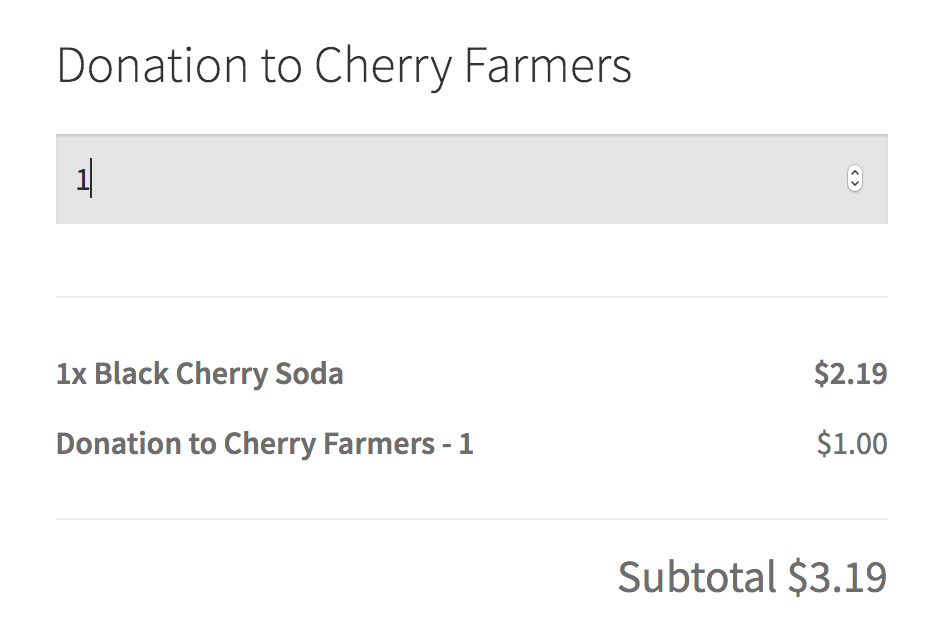
 by
by